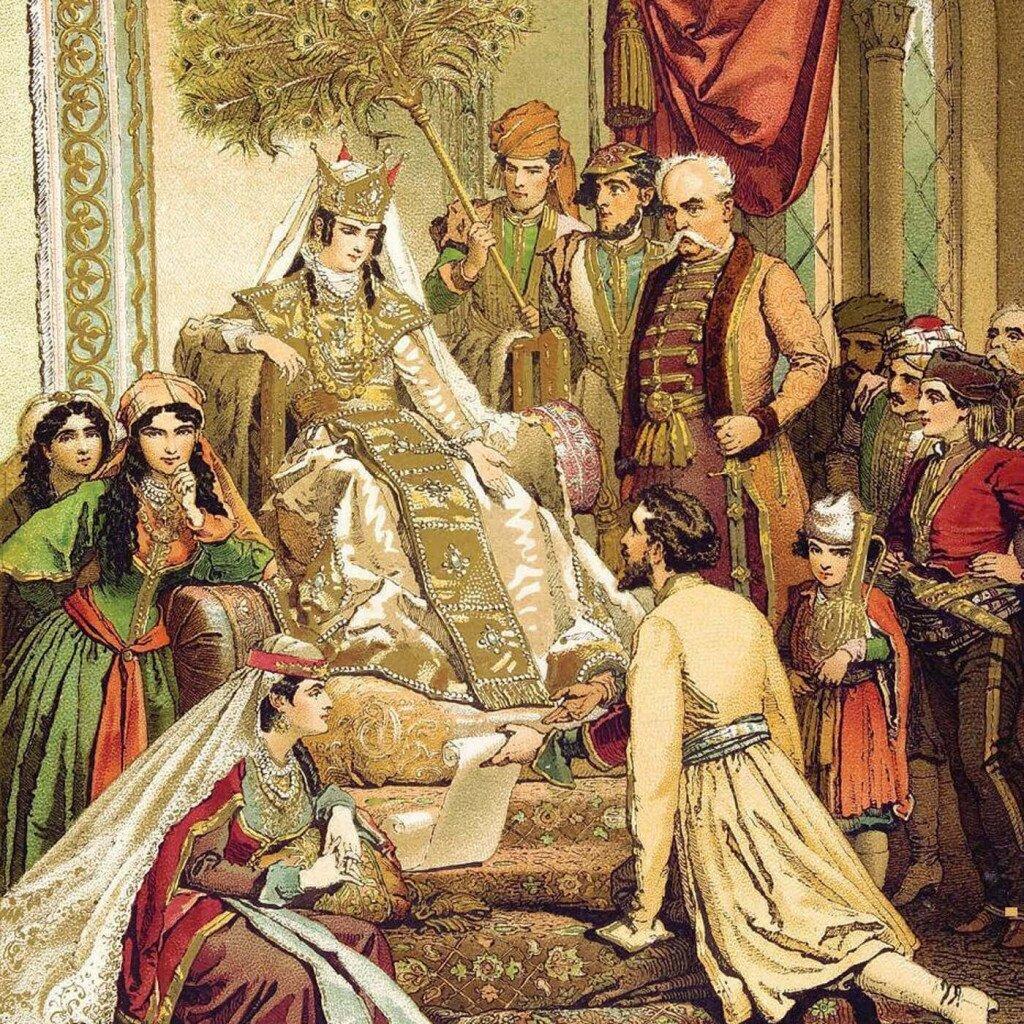Tamar:
Queen of Kings
Tamar:
Queen of Kings
3:40
24 Sep 2020
On December 16, 2018, the country of Georgia swore in its first female president, Salome Zourabichvili. But Georgia’s history of putting women in positions of power stretches back as far as biblical times.
The country has always held women in the highest regard. In fact, respect is so apparent and so ancient, the Georgian language has no grammatical references for gender—meaning a word like “king” basically means ruler and the same thing as “queen.” And so it was in the year 1160 when Queen Tamar was born into the royal family of King George III, the ruler during the peak of the Georgian “Golden Age.” The boundaries of the realm stretched southward from the imposing Caucasus mountain range and the shores of the Black Sea into modern-day Armenia and northern Iran.
Young Tamar, as a successor to the throne, was in a unique position: No woman had ever ruled over Georgia. But King George committed to making young Tamar his heir and had her crowned queen while he was still alive—a bit of a “daddy-daughter duo,” as he proclaimed that they would rule the country together. George wanted to show her the royal ropes, in a sense, and help her secure her rule over the many powerful nobles operating throughout the kingdom. Her coronation took place when she was just 12 years old. Writings from the time describe a woman as beautiful as she was wise, and frescos that adorn cathedrals depict her with long, lustrous dark hair, an attenuated “swan-like” neck, and large, caring, intelligent eyes. She was a patron of the arts, a devout Christian, and a supporter of science and innovation.
When her father died, she ascended to the primary ruling position and Queen Tamar became “King Tamar,” the only woman to ever be a king. Aside from the grammatical indifference the Georgians had for gender in their language, they calculated that neighboring realms would have more respect for Tamar as a king rather than a queen, thus explaining the peculiar title. The culture flourished under her guidance. As a warrior, she crushed several formidable enemies in battle and further expanded the boundary of the kingdom southward into modern-day Turkey.
While completely in charge, Tamar was subject to the influences of the powerful nobles controlling districts within the realm. And so, it was decided that she should take a husband. A young nobleman from Russia, Prince Yuri, was selected as the groom. The Prince, accompanying his military accomplishments, was skilled at drinking heavily, starting fights, and being unfaithful to Tamar. Luckily, her strong ties to the church allowed her to enact a rare divorce, remarry, and produce two children with a more worthy nobleman.
Today, she is a beloved saint of the Orthodox Church and a regaled ruler who is remembered by the many religious buildings she commissioned as well as a feast day each May to celebrate her numerous contributions to Georgian culture.
On December 16, 2018, the country of Georgia swore in its first female president, Salome Zourabichvili. But Georgia’s history of putting women in positions of power stretches back as far as biblical times.
The country has always held women in the highest regard. In fact, respect is so apparent and so ancient, the Georgian language has no grammatical references for gender—meaning a word like “king” basically means ruler and the same thing as “queen.” And so it was in the year 1160 when Queen Tamar was born into the royal family of King George III, the ruler during the peak of the Georgian “Golden Age.” The boundaries of the realm stretched southward from the imposing Caucasus mountain range and the shores of the Black Sea into modern-day Armenia and northern Iran.
Young Tamar, as a successor to the throne, was in a unique position: No woman had ever ruled over Georgia. But King George committed to making young Tamar his heir and had her crowned queen while he was still alive—a bit of a “daddy-daughter duo,” as he proclaimed that they would rule the country together. George wanted to show her the royal ropes, in a sense, and help her secure her rule over the many powerful nobles operating throughout the kingdom. Her coronation took place when she was just 12 years old. Writings from the time describe a woman as beautiful as she was wise, and frescos that adorn cathedrals depict her with long, lustrous dark hair, an attenuated “swan-like” neck, and large, caring, intelligent eyes. She was a patron of the arts, a devout Christian, and a supporter of science and innovation.
When her father died, she ascended to the primary ruling position and Queen Tamar became “King Tamar,” the only woman to ever be a king. Aside from the grammatical indifference the Georgians had for gender in their language, they calculated that neighboring realms would have more respect for Tamar as a king rather than a queen, thus explaining the peculiar title. The culture flourished under her guidance. As a warrior, she crushed several formidable enemies in battle and further expanded the boundary of the kingdom southward into modern-day Turkey.
While completely in charge, Tamar was subject to the influences of the powerful nobles controlling districts within the realm. And so, it was decided that she should take a husband. A young nobleman from Russia, Prince Yuri, was selected as the groom. The Prince, accompanying his military accomplishments, was skilled at drinking heavily, starting fights, and being unfaithful to Tamar. Luckily, her strong ties to the church allowed her to enact a rare divorce, remarry, and produce two children with a more worthy nobleman.
Today, she is a beloved saint of the Orthodox Church and a regaled ruler who is remembered by the many religious buildings she commissioned as well as a feast day each May to celebrate her numerous contributions to Georgian culture.


